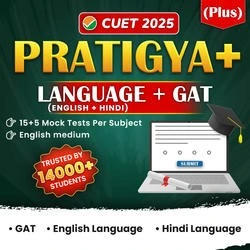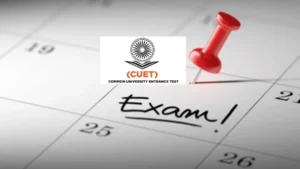Table of Contents
Vitamins are crucial nutrients necessary for our body to operate effectively. They are essential for supporting growth, development, and general well-being. In this detailed guide, we will examine the various kinds of vitamins, their advantages, and their scientific names to assist you in excelling in your exams and remaining knowledgeable. Master Vitamins & Their Scientific Names for CUET GAT 2025 in this post. 🚀
Vitamins & Their Scientific Names for CUET GAT 2025
The Common University Entrance Test (CUET) exam’s General Aptitude Test or GAT Section consists of questions from Vitamins topic. Candidates preparing for the CUET GAT exam paper must learn all the concepts related to Vitamins including its classification. To help students, we have provided all the information that a CUET UG aspirant need for the Vitamin concept in this article. Make sure to practice important questions given in the end to boost your conceptual understanding. First of all, let us understand what are Vitamins.
🌟 What Are Vitamins?
Vitamins are organic substances essential for normal bodily functions. They promote cell development, enhance bone and muscle strength, assist in wound healing, and improve the immune response. As our body is unable to create most vitamins, it is crucial to acquire them through food and supplements.
CUET GAT 2025 | Vitamins & Their Scientific Names Explained! 🔥
Vitamins are crucial nutrients necessary for our body to operate effectively. They are essential for supporting growth, development, and general well-being. There are different types of vitamins that are essential for the effective operation of our body. When a deficient diet causes your body to lack essential nutrients for an extended period, it will signal you. You can overcome many of these problems with foods abundant in the lacking nutrient.
🕰️ History of Vitamins
The identification of vitamins traces back to 1912, when Casimir Funk, recognized as the Father of Vitamins, initially discovered these vital nutrients. He introduced the term “vitamine” after identifying compounds essential for life.
🧩 Classification of Vitamins
While there are various types of Vitamins, they can be broadly classified into two categories: Fat-Soluble Vitamins and Water-Soluble Vitamins. Learn about them below.
1. Fat-Soluble Vitamins 🧈: These vitamins dissolve in fats and are stored in the body’s fatty tissues. The key fat-soluble vitamins are:
- 🥕 Vitamin A (Retinol): Essential for vision and skin health.
- 🌞 Vitamin D (Calciferol): Promotes bone and teeth health.
- 🥑 Vitamin E (Tocopherol): Acts as an antioxidant and protects cell membranes.
- 🥬 Vitamin K (Phylloquinone): Helps in blood clotting and bone metabolism.
💡 Trick to Remember Fat-Soluble Vitamins: The acronym “KEDA” (K, E, D, A) helps remember these four vitamins easily!
2. Water-Soluble Vitamins 💧: These vitamins cannot dissolve in fat and oil but can dissolve in water. Water-soluble vitamins are simple to consume routinely. They are present in numerous dishes, especially leafy greens and ripe fruits.
These vitamins dissolve in water and are not stored in the body. Excess amounts are excreted through urine, so regular intake is necessary.
The important water-soluble vitamins include:
1) 🥛 Vitamin B-Complex (8 Types)
- B1 (Thiamine): Supports energy metabolism.
- B2 (Riboflavin): Maintains skin and eye health.
- B3 (Niacin): Boosts brain function and energy production.
- B5 (Pantothenic Acid): Vital for hormone production.
- B6 (Pyridoxine): Supports brain development and function.
- B7 (Biotin): Strengthens hair, skin, and nails.
- B9 (Folate): Crucial for DNA synthesis and repair.
- B12 (Cobalamin): Maintains nerve and blood cell health.
2) 🍊 Vitamin C (Ascorbic Acid): Enhances immune function and skin health.
💡 Trick to Remember Water-Soluble Vitamins
📝 Trick to Remember B-Complex: Memorize the phrase: “The Really Nice Parents Prefer Big Fruits Carefully”. The starting letter of each word denotes one Vitamin B complex name as shown below.
- T: Thiamine
- R: Riboflavin
- N: Niacin
- P: Pantothenic Acid
- P: Pyridoxine
- B: Biotin
- F: Folate
- C: Cobalamin
📝 Why Are Vitamins Important?
The Vitamins are useful for us in many ways. Some important functions of Vitamins are:
✅ Improves Bone and muscle strength
✅ Helps in Cell function and repair
✅ Provides essential Immune system support
✅ Crucial for Energy metabolism and brain health
As certain vitamins are not retained in the body, consistent intake is essential for optimal health and to avert deficiencies.
🚩 How to Prepare the Vitamins Topic for CUET GAT Exam
Follow the tips mentioned below to prepare the topic of Vitamins for CUET UG GAT 2025 exam.
- Never forget the scientific names of vitamins, as they are often requested in competitive tests.
- Use memory aids and techniques to learn the categories and names.
- Continue reviewing with brief notes and quick references.
Sources of Vitamins
Organic substances are abundant in both flora and fauna, and they are crucial for growth, development, and overall well-being. This table illustrates various kinds of vitamins along with their sources.
|
Scientific Name of Vitamin
|
Common Name of the Vitamin
|
Food Sources
|
|
Retinol
|
Vitamin A (Fat-soluble)
|
Green leafy vegetables, nuts, tomatoes, oranges, ripe yellow fruits, guava, milk, liver, carrots, broccoli and watermelon.
|
|
Thiamine
|
Vitamin B1 (Water-soluble)
|
Fresh fruits, corn, cashew nuts, potatoes, sweet potatoes, peas, wheat, milk, dates, black beans, etc.
|
|
Riboflavin
|
Vitamin B2 (Water-soluble)
|
Bananas, grapes, mangoes, peas, pumpkin, dates, yoghurt, milk, mushrooms, popcorn, beef liver, etc.
|
|
Niacin
|
Vitamin B3 (Water-soluble)
|
Meat, eggs, fish, milk products, guava, mushroom, peanuts, cereals, green peas, etc.
|
|
Pantothenic Acid
|
Vitamin B5 (Water-soluble)
|
Meat, kidney, egg yolk, broccoli, peanuts, fish, chicken, milk, yoghurt, legumes, mushrooms, avocado, etc.
|
|
Pyridoxine
|
Vitamin B6 (Water-soluble)
|
Pork, chicken, fish, bread, wholegrain cereals, eggs, vegetables, soya beans, etc.
|
|
Biotin
|
Vitamin B7 (Water-soluble)
|
Walnuts, peanuts, cereals, milk, egg yolks, salmon, pork, mushroom, cauliflower, avocados, bananas, raspberries, etc.
|
|
Folic Acid
|
Vitamin B9 (Water-soluble)
|
Citrus fruits, green leafy vegetables, whole grains, legumes, beets, etc.
|
|
Cobalamin
|
Vitamin B12 (Water-soluble)
|
Fish, meat, poultry, eggs, milk, etc.
|
|
Ascorbic acid
|
Vitamin C (Water-soluble)
|
Fresh citrus fruits such as orange and grapefruit, broccoli, goat milk, black currant and chestnuts.
|
|
Calciferol
|
Vitamin D (Fat-soluble)
|
Fish, beef, cod liver oil, egg yolk, liver, chicken breast and cereals.
|
|
Tocopherol
|
Vitamin E (Fat-soluble)
|
Potatoes, pumpkin, guava, mango, milk, nuts and seeds.
|
|
Phytonadione
|
Vitamin K (Fat-soluble)
|
Tomatoes, broccoli, mangoes, grapes, chestnuts, cashew nuts, beef and lamb.
|
Deficiencies Caused by Vitamins
An adequately balanced diet is crucial for an individual’s overall well-being. Any imbalance in diet may lead to either an excess or a deficiency of specific nutrients. A deficiency condition can occur due to an absence of a specific nutrient. Below are some deficiency diseases that may result from a diet lacking certain vitamins.
| Disease Name | Deficiency cause by the Vitamin |
| Night blindness | A (Retinol) |
| Beri-Beri | B1 (Thiamine) |
| Retarded growth, bad skin | B2 (Riboflavin) |
| Anaemia | B12 (Cyanocobalamin) |
| Scurvy | C (Ascorbic acid) |
| Rickets | D (Calciferol) |
| Excessive bleeding due to injury | K (Phylloquinone) |
Vitamins & Their Scientific Names for CUET GAT 2025- Detailed Video
Go through this one-shot video on Vitamins for the CUET UG 2025 GAT exam below for complete clarity.
CUET GAT 2025 Vitamins Important Questions with Answers
Candidates should practice some of the important questions on Vitamins given below to cement the concept of Vitamins in their mind for CUET UG 2025 exam. Make sure you check answers after your have responded the questions first by yourself.
Q) Which of the following vitamins is stored in the liver?
1. Vitamin K
2. Vitamin D
3. Vitamin E
4. More than one of the above
5. None of the above
Ans: 4. More than one of the above
Q) Which of the following vitamin is most easily destroyed vitamin while cooking?
1. Vitamin B12
2. Vitamin C
3. Vitamin B4
4. More than one of the above
5. None of the above
Ans: 2. Vitamin C
Q) Which of the following food sources has the highest levels of vitamin C?
1. Parsley
2. Broccoli
3. Black currants
4. Orange juice
5. Cucumber
Ans: 3. Black currants.
Q) Which of the following vitamin helps in blood clotting?
1. Vitamin A
2. Vitamin B
3. Vitamin D
4. Vitamin C
5. Vitamin K
Ans: 5. Vitamin K
Q)
What is the vitamin deficiency in milk?
1. D
2. B Complex
3. A
4. C
5. K
Ans: 4. C
🌟 Vitamins are essential for our health and overall well-being. Understanding their classifications and scientific names is essential, not just for tests but also for sustaining a healthy lifestyle. Ensure you incorporate a well-rounded diet to obtain these vital nutrients and enhance your body’s efficiency. Maintain your health and stay wise! 💪




 CUET UG Exam Date Sheet 2025 @cuet.nta.n...
CUET UG Exam Date Sheet 2025 @cuet.nta.n...
 CUET Accountancy Chapter Wise Weightage ...
CUET Accountancy Chapter Wise Weightage ...
 CUET English Question Paper (2024, 2023)...
CUET English Question Paper (2024, 2023)...




